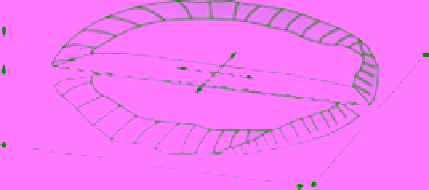Geoscience Reference
In-Depth Information
liquefaction for the origin of facies S
M
. An escape
of pore water would increase grain packing and
redistribute pore-clogging fines (Allen, 1982; Nago
et al
., 1993; Vaid & Thomas, 1995), thereby reduc-
ing both primary porosity and permeability.
Planar cross-stratification (facies S
CS
) is an
important source of heterogeneity in sandstone
reservoirs (Weber, 1986; Weber & Van Geuns,
1990) and the permeability anisotropy of cross-
strata sets differs markedly from that of the other
sandstone facies (Fig. 14; Weber, 1982). This
aspect is reflected in the high variance of core-
plug data. The mean porosity of facies S
CS
is 13%,
with a standard deviation of 4% and the mean
horizontal permeability is 2.03 mD with a stand-
ard deviation of 6.24 mD (Fig. 13D). The ratio of
vertical to horizontal permeability is mainly in
the range of 0.4 to 0.7, but the permeability paral-
lel to foreset strata varies and may be up to four
times higher than the permeability normal to the
strata (Emmett
et al
., 1971). Importantly, the semi-
isolated sandstone ridges composed of facies S
CS
(Fig. 12) are surrounded by less permeable facies
and are internally quite heterogeneous, which
may hinder the release of condensate from these
reservoir compartments and considerably delay
spatial equalisation of reservoir pressure.
The sand grain size of foreset strata in facies S
CS
varies between very fine/fine and medium, or
between fine/medium and coarse to very coarse in
some cross-sets. The bundles of coarser-grained
and finer-grained strata may differ in permeability
by nearly an order of magnitude (Weber, 1986;
Rosvoll, 1989). This heterogeneity and anisotropy
of sandstone cross-strata sets will be of minor
importance for the recovery of gas from a perme-
able reservoir but will be of major importance in
an oil reservoir (Emmett
et al
., 1971; Weber, 1986)
and may also play a significant role in the flow
and retention of fluids in a less permeable reser-
voir containing gas and condensate (Elfenbein
et al
., 2005; Quin
et al
., 2010).
Approximately 20% of the cross-strata sets in
facies S
CS
include bottomsets, 5 cm to 25 cm thick
(e.g. Fig. 6H), which are finer-grained, poorer
sorted, richer in mud drapes and containing
backflow ripple intrasets. Although the bottom-
sets are likely to be laterally discontinuous and of
limited extent (De Raaf & Boersma, 1971; Nio
et al
., 1983), they may act as significant permea-
bility baffles (Fig. 14).
In a reservoir, the cross-strata sets act as
anisotropic mini-compartments separated by
high-angle angular unconformities and textural
permeability baffles. The cross-strata sets form
sandstone ridges that constitute a major part of the
Garn Formation (Fig. 8) and hence the volumetric
aspect of cross-sets is of crucial importance to the
reservoir characterisation. The measured cross-set
thicknesses show great variation and a similarly
wide variation can be expected for the unknown
cross-set volumes. In a subsequent section, we
demonstrate how the frequency distribution of
measured cross-set thicknesses can be used on a
statistical basis to estimate the frequency distribu-
tion of cross-set volumes.
(A)
L
x
≈
L
y
»
h
k
y
h
k
x
L
y
L
x
(B)
L
x
L
y
h
Foreset
k
v
k
n
k
h
b
k
p
k
v
(
b
)
k
h
(
b
)
Bottomset
cos
2
sin
2
k
p
≈
1/4
k
n
k
v
(
b
)
≈
1/2
k
v
1
k
h
k
p
k
n
For linear displacement:
For radial displacement:
1
b
1
k
r
= (
k
x
k
y
)
1/2
k
x
L
x
k
h
(
b
)
k
h
1
b
1
k
y
L
y
k
h
(
b
)
k
p
Fig. 14.
(A) Definition sketch of dune cross-set dimensions,
with
k
denoting permeability. The horizontal permeability
of dune cross-set is considerably different in the direction
parallel and transverse to the strike of cross-strata, with
k
x
<
k
y
. (B) The inherent high permeability anisotropy ren-
ders tidal dune cross-sets (facies S
CS
) the main element of
Garn Fm. reservoir heterogeneity. Relationships compiled
from Weber (1982), with the symbols denoting:
k
h
and
k
v
− horizontal and vertical foreset permeability;
k
h(b)
and
k
v(b)
− horizontal and vertical bottomset permeability;
k
p
and
k
n
− permeability parallel and normal to foreset cross-strata.


Search WWH ::

Custom Search